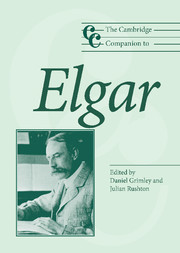Book contents
- Frontmatter
- 1 Introduction
- 2 Elgar and his British contemporaries
- 3 Elgar and his publishers
- 4 Magic by mosaic: some aspects of Elgar's compositional methods
- 5 Elgar's musical language: the shorter instrumental works
- 6 The early choral works
- 7 Elgar's later oratorios: Roman Catholicism, decadence and the Wagnerian dialectic of shame and grace
- 8 Roman Catholicism and being musically English: Elgar's church and organ music
- 9 ‘A smiling with a sigh’: the chamber music and works for strings
- 10 In search of the symphony: orchestral music to 1908
- 11 The later orchestral music (1910–34)
- 12 Elgar's unwumbling: the theatre music
- 13 Elgar and recording
- 14 Broadcasting's ally: Elgar and the BBC
- 15 Elgar in German criticism
- 16 Functional music: imperialism, the Great War, and Elgar as popular composer
- Notes
- Select bibliography
- Index
16 - Functional music: imperialism, the Great War, and Elgar as popular composer
Published online by Cambridge University Press: 28 September 2011
- Frontmatter
- 1 Introduction
- 2 Elgar and his British contemporaries
- 3 Elgar and his publishers
- 4 Magic by mosaic: some aspects of Elgar's compositional methods
- 5 Elgar's musical language: the shorter instrumental works
- 6 The early choral works
- 7 Elgar's later oratorios: Roman Catholicism, decadence and the Wagnerian dialectic of shame and grace
- 8 Roman Catholicism and being musically English: Elgar's church and organ music
- 9 ‘A smiling with a sigh’: the chamber music and works for strings
- 10 In search of the symphony: orchestral music to 1908
- 11 The later orchestral music (1910–34)
- 12 Elgar's unwumbling: the theatre music
- 13 Elgar and recording
- 14 Broadcasting's ally: Elgar and the BBC
- 15 Elgar in German criticism
- 16 Functional music: imperialism, the Great War, and Elgar as popular composer
- Notes
- Select bibliography
- Index
Summary
As Edward Elgar's compositions for imperial ceremonies and the First World War have specific functions (royal celebrations, marching music, rallying cries, and charitable offerings), they can be considered together within an analysis. The compositions share a number of characteristics: none is abstract in nature, Elgar composed many of them to sound specifically ‘popular’, and none can claim ‘secret’ or ‘hidden’ meanings, like the ‘Enigma’ Variations or the Violin Concerto. In the period before the war, these compositions solidified Elgar's reputation as an important national figure. During the war, they aptly represented the complex difficulties individual Britons faced from the violence and carnage of battle. After the war, they placed Elgar in the forefront of society as an official ceremonial figure. They allowed him to represent a musical tradition rapidly declining throughout elite Great Britain, but prominent in middle-class quarters. These works were inspirational in their own time, and many are still rousing today. As important examples of period pieces, they show Elgar transcending the limits of concert music to successfully negotiate popular forms.
Throughout this chapter, ‘popular’ describes music that might be easily disseminated, might be performed in non-elite contexts and venues (bandstands, rallies, music-halls, the London Coliseum, etc.), or might have been written by Elgar to garner a broad audience. A close analogy to this type of composition would be Beethoven's Wellingtons Sieg (or ‘Battle Symphony’), a potboiler meant to capture timely sentiment. Elgar often designed his ‘functional’ music to be popular through concentrating on broad styles of composition, including singable melody as opposed to motivic transformation.
- Type
- Chapter
- Information
- The Cambridge Companion to Elgar , pp. 214 - 224Publisher: Cambridge University PressPrint publication year: 2005



